Westside Toastmasters is located in West Los Angeles and Santa Monica, California
Chapter 5
CULTURAL VARIATIONS IN GESTURES

The businessman on the left is unaware that he has committed a major gaffe. In Middle Eastern cultures it is insulting to cross an ankle over a knee and display the sole of the shoe while talking to another person. Conducting business just became more complicated.
Do we expect other cultures to adopt our customs or are we willing to adopt theirs? This might translate to how business or even foreign relations are to be conducted. Do we compromise or force others peoples to deal only on our terms? We may not have time to hear a language , but taking time to learn the "signals" is a powerful communicator.
As the global village continues to shrink and cultures collide, it is essential for all of us to become more sensitive, more aware, and more observant to the myriad motions, gestures, and body language that surround us each day. And as many of us cross over cultural borders, it would be fitting for us to respect, learn, and understand more about the effective, yet powerful "silent language" of gestures.
The world is a giddy montage of vivid gestures - traffic police, street vendors, expressway drivers, teachers, children on playground, athletes with their exuberant hugging, clenched fists and "high fives." People all over the world use their hands, heads, and bodies to communicate expressively.
In recent years, Western and contemporary values and ideas have become more popular and have either influenced, altered, and even replaced, some of the more traditional gestures. Understanding human behavior is tricky stuff. No two people behave in precisely the same way. Nor do people from the same culture all perform exactly the same gestures and body language uniformly. For almost any gestures there will probably be a minority within a given nationality who might say "Well, some might attach that meaning to it, but to me it means..." and then they will provide a different interpretation.
In the world of gestures, the best single piece of advice is to remember the two A's - "Ask" and be "Aware." If you see a motion or gesture that is new or confusing , ask a local person what it signifies. Then, be aware of the many body signs and customs around you.
We Were Having Pizza at the Time
Imagine this scene - you are inspecting a house with the possibility of purchasing it and you open a bathroom door to see a woman sitting naked in a bathtub. How would you expect the surprised woman to react? A British or American woman would cover her breasts with one hand and her genitals with the other, while a Swedish woman would cover only her genitals. A Muslim woman would cover her face, a Sumatran woman would cover her knees and a Samoan only her navel.
All cultures walk on the same side of the pavement as they drive on the road. This means if you're British, Australian, South African or a New Zealander, you drive and walk to the left. In Italy for example the consequence is that you'd find the Italians constantly bumping into you as you walk on the pavement because, as they approach and you step to your left, they step to their right. Wearing sunglasses in foreign countries is the single biggest cause of pavement collisions between cultures because no one can see the other person's gaze to know which way they intend to step. But it's a novel way of meeting new and interesting foreigners.
You would be stunned when you go to shake hands to say goodbye to an Italian but, instead, you get a kiss on both cheeks.
As I departed, the Italian man kissed me on both cheeks. I was tying my shoelaces at the time.
Woody Allen
As you talk with local Italians, they seem to stand in your space, continually grabbing you, talking over the top of you, yelling in fact, and sounding angry about everything. But these things are a normal part of everyday friendly Italian communication. Not all things in all cultures mean the same things.
Take the Cultural Test
How aware are you of cultural differences in body language? Try this exercise - hold up your main hand to display the number five - do it now. Now change it to the number two. If you're Anglo-Saxon, there's a 96% chance you'll be holding up your middle and index fingers. If you're European, there's a 94% chance you'll be holding up your thumb and index finger. Europeans start counting with the number one on the thumb, two on the index finger, three on the middle finger, and so on. Anglo-Saxons count number one on the index finger, two on the middle finger and finish with five on the thumb.
Now look at the following hand signals and see how many different meanings you can assign to each one. For each correct answer, score one point and deduct one point for an incorrect answer. The answers are listed at the bottom of the page.
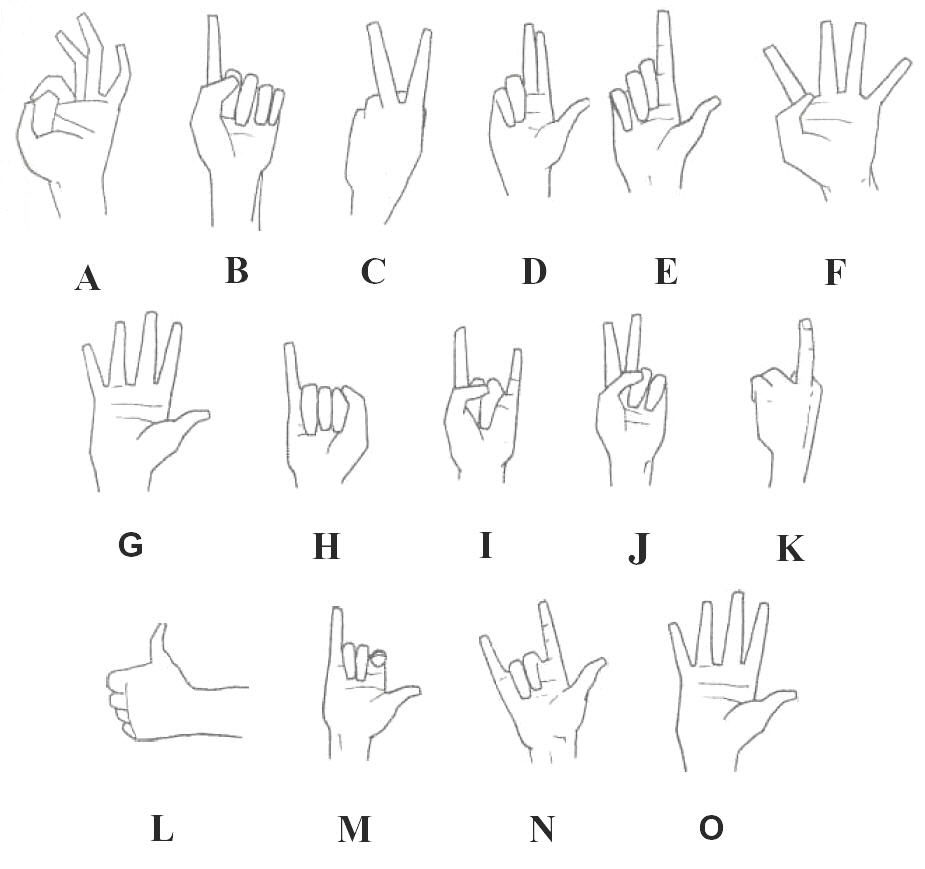
For each correct answer you got, allocate yourself one point.
What did you score?
Over 30 points: You are a well-travelled, well-rounded, broad-thinking person who gets on well with everyone regardless of where they are from. People love you.
15-30 points: You have a basic awareness that others behave differently to you and, with dedicated practice, you can improve the understanding you currently have. 15 points or less: You think everyone thinks like you do. You should never be issued a passport or even be allowed out of the house. You have little concept that the rest of the world is different to you and you think that it's always the same time and season all over the world. You are probably an American.Why We're All Becoming More American
Due to the wide distribution of American television and movies, the younger generations of all cultures are developing a generic form of North American body language. For example, Australians in their sixties will identify the British Two-Fingers-Up gesture as an insult whereas an Australian teenager is more likely to read it as the number two and will recognize the American Middle-Finger-Raised as a main form of insult. Most countries now recognize the Ring gesture as meaning 'OK', even if it's not traditionally used locally. Young children in every country that has television now wear baseball caps backwards and shout 'Hasta la vista, baby', even if the don't understand Spanish.
American television is the prime reason cultural body language differences are disappearing.
The word 'toilet' is also slowly disappearing from the English language because North Americans, whose ancestral roots are as rugged pioneers and log splitters, are loath to say it. North Americans wil ask for the 'bathroom', which, in many parts of Europe, contains a bath. Or they ask for a 'rest room' and are taken to where there are lounge seats to relax. In England, a 'powder room' contains a mirror and washbasin, a 'little girls' room' is found in a kindergarten and 'comfort stations' are positioned on the motorways of Europe. And a North American who asks to 'wash up' is likely to be gleefully led to the kitchen, given a tea towel and invited to wash the dishes.
Cultural Basics are the Same Almost Everywhere
As discussed earlier, facial expressions and smiles register the same meanings to people almost everywhere. Paul Ekman of the University of California, San Francisco, showed photographs of the emotions of happiness, anger, fear, sadness, disgust and surprise to people in 21 different cultures and found that in every case, the majority in each country agreed about the pictures that showed happiness, sadness and disgust. There was agreement by the majority in 20 out of the 21 countries for the surprise expressions, for fear on 19 out of 21 agreed and for anger, 18 out of 21 agreed. The only significant cultural difference was with the Japanese who described the fear photograph as surprise.
Ekman also went to New Guinea to study the South Fore culture and the Dani people of West Irian who had been isolated from the rest of the world. He recorded the same results, the exception being that, like the Japanese, these cultures could not distinguish fear from surprise.
He filmed these stone-age people enacting these same expressions and then showed them to Americans who correctly identified them all, proving that the meanings of smiling and facial expressions are universal.
The fact that expressions are inborn in humans was also demonstrated by Dr Linda Camras from DePaul University in Chicago. She measured Japanese and American infants' facial responses using the Facial Action Coding System. This system allowed researchers to record, separate and catalogue infant facial expressions and they found that both Japanese and American infants displayed exactly the same emotional expressions.
So far in this resource the focus has been on body language that is generally common to most parts of the world. The biggest cultural differences exist mainly in relation to territorial space, eye contact, touch frequency and insult gestures. The regions that have the greatest number of different local signals are Arab countries, parts of Asia and Japan. Understanding cultural differences is too big a subject to be covered in a short space, consequently the emphasis here is on the basic things that you are likely to see abroad.
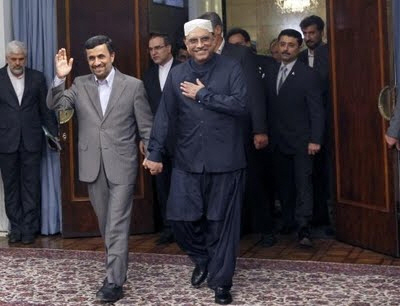
If a Middle Eastern man holds another man's hand in public, as is done here by Pakistani President Asif Ali Zandariit with Iranian President Mahmoud Ahmadinejad, it's a sign of mutual respect. But don't do it in Texas, USA or Liverpool, England
Greeting Differences
Handshaking differences can make for some embarrassing and humorous cultural encounters. British, Australian, New Zealander, German and American colleagues will usually shake hands on meeting, and again on departure. Most European cultures will shake hands with each other several times a day, and some French have been noted to shake hands for up to 30 minutes a day. Indian, Asian and Arabic cultures may continue to hold your hand when the handshake has ended. Germans and French give one or two firm pumps followed by a short hold, whereas Brits give three to five pumps compared with an American's five to seven pumps. This is hilarious to observe at international conferences where a range of different handshake pumping takes place between surprised delegates. To the Americans, the Germans, with their single pump, seem distant. To the Germans however, the Americans pump hands as if they are blowing up an airbed.
When it comes to greeting with a cheek kiss, the Scandinavians are happy with a single kiss, the French mostly prefer a double, while the Dutch, Belgians and Arabs go for a triple kiss. The Australians, New Zealanders and Americans are continually confused about greeting kisses and bump noses as they fumble their way through a single peck. The British either avoid kissing by standing back or will surprise you with a European double kiss. In his book A View from the Summit, Sir Edmund Hillary recounts that on reaching the peak of Everest, he faced Sherpa Tenzing Norgay and offered a proper, British, congratulatory handshake. But Norgay leaped forward and hugged and kissed him - the proper congratulations of Tibetans.
When One Culture Encounters Another
When Italians talk they keep their hands held high as a way of holding the floor in a conversation. What seems like affectionate arm touching during an Italian conversation is nothing more than a way of stopping the listener from raising his hands and taking the floor. To interrupt an Italian you must grab his hands in mid air and hold them down. As a comparison the Germans and British look as if they are physically paralyzed when they talk. They are daunted when trying to converse with Italians and French and rarely get an opportunity to speak. French use their forearms and hands when they talk, Italians use their entire arms and body, while the British and Germans stand at attention.
When it comes to doing international business, sharp dressing, excellent references and a good proposal can all become instantly unstuck by the smallest, most innocent gesture sinking the whole deal. Research in 50 countries shows North Americans to be the least culturally aware people with the British coming in a close second. Considering that 80% of North Americans don't have a passport, it follows that they would be the most ignorant of international body language customs. Even George W Bush had to apply for a passport after becoming President of the United States so he could travel overseas. The British, however, do travel extensively but prefer everyone else to use British body signals, speak English and serve fish and chips. Most foreign cultures do not expect you to learn their language but are extremely impressed by the traveller who has taken the time to learn and use local body language customs. This tells them that you respect their culture.
The English Stiff-Upper-Lip
This gesture relates to pursing the lips to control the face so that facial expressions are reduced and as little emotion as possible is shown. This way the English can give the impression of being in complete emotional control. When Princes Philip, Charles, Harry and William walked behind the coffin of Diana in 1997, they each held the Stiff-Upper-Lip expression, which, to many in the non-British world, came across a unemotional about Diana's death.
King Henry VIII was famous for pulling the Lips-Pursed expression. He had a small mouth and when he stiffened his upper lip for a portrait it looked even smaller. This habit led to a small mouth being a superiority signal among the English of the sixteenth century. The Lips-Pursed is an expression still used today by English people when they feel they are being intimidated by inferior people and this gesture is often accompanied by extended eye blinks.



King Henry VIII popularized this gesture as a high-status signal because of his small mouth; Americans and the English still use it
The Japanese
One area where handshakes, kissing and bear hugs have not become established is Japan, where such bodily contact is considered impolite. Japanese people bow on first meeting, the person with the highest status bowing the least and the one with the least status bowing the most. On first meeting, business cards are exchanged, each person assesses the others status and appropriate bowing follows.
In Japan, make sure your shoes are spotlessly clean and in good condition. Every time a Japanese bows, he inspects them.
The Japanese way of listening to someone involves a repertoire of smiley nods and polite noises, which have no direct equivalent in other languages. The idea is to encourage you to keep on talking but this is often misinterpreted by Westerners and Europeans as agreement. The Head Nod is an almost universal sign for 'yes', except for the Bulgarians who use the gesture to signify 'no', and the Japanese who use it for politeness. If you say something a Japanese doesn't agree with, he'll still say 'yes' - or Hai in Japanese - to keep you talking. A Japanese 'yes' usually means, 'yes, I heard you' and not 'yes, I agree'. For example, if you say to a Japanese person 'you don't agree, do you?' he will nod his head and say 'yes' even though he may not agree. In the Japanese context, it means 'Yes, you are correct - I don't agree.'
The Japanese are concerned with saving face and have developed a set of rules to prevent things going wrong so try to avoid saying no or asking questions when the answer might be no. The closest a Japanese will get to saying the word no is, 'It is very difficult,' or 'We will give this positive study' when they really mean, 'Let's forget the whole thing and go home.'
'You Filthy Pig!' - Blowing Your Nose
Europeans and Westerners blow their noses into a handkerchief or tissue while Asians and Japanese spit or snort. Each is appalled by what they see as the other's 'disgusting' behavior. This dramatic cultural difference is the direct result of the spead of tuberculosis in past centuries. In Europe, tuberculosis was the AIDS of the era - a disease from which there was little hope of survival so governments instructed people to blow their nose to avoid further spreading the disease. This is why Westerners react so strongly to spitting - a spitting person could spread tuberculosis around, so people were as alarmed by that prospect as they would be if you could spread AIDS by spitting.
Modern nose-blowing is the result of a post epidemic of tuberculosis.
If tuberculosis had been a problem in Eastern countries, the cultural reaction would be the same as with Westerners. As a result the Japanese are appalled when someone produces a handkerchief, blows their nose into it and puts it back in their pocket purse or up their sleeve! Japanese are unimpressed at the English custom of men wearing a handkerchief in their jacket top pocket. This is the equivalent of proudly dangling a roll of toilet paper from the pocket, ready for action. Asians believe, correctly, that it is a healthier option to spit but it is a habit that is repulsive to Westerners and Europeans. This is why business meetings between Westerners and Europeans can fail when they've all got a cold. So don't feel upset by an Asian who spits or snorts and never blow your nose in front of a Japanese person.
The Three Most Common Cross-Cultural Gestures
Let's examine the cultural interpretations and implications of three common hand gestures, the Ring, the Thumb-Up and the V-sign.
1. The Ring
This gesture was popularized in the USA during the early nineteenth century by the newspapers that were starting a craze or using initials to shorten common phrases. There are many different views about what the initials 'OK' originally stood for, some believing it stood for 'all correct' which was regularly misspelled as 'oil korrect', while others say that it means the opposite of 'knock-out' that is, KO.
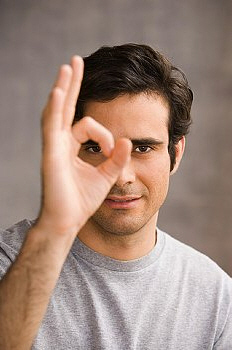
'OK' to a Westerner, 'money' to a Japanese, 'zero' to the French and insulting to the Turks and Brazilians
Another popular theory is that it is an abbreviation of 'Old Kinderhook', from the birthplace of a nineteenth-century American president who used the initials as a campaign slogan. It's obvious that the ring itself represents the letter 'O' in the 'OK' signal. The 'OK' meaning is common to all English-speaking countries and its meaning is fast spreading everywhere due to American TV and movies, but it has other origins and meanings in certain places. In France and Belgium it also means 'zero' or 'nothing'. In a Paris restaurant one evening, the waiter showed us to our table and asked, 'Is the table OK?' We flashed him the OK signal and he responded, 'Well, if you do not like it here we'll find you another table...' He had interpreted the OK signal as meaning 'zero' or 'worthless' - in other words, he thought we had communicated that we did not like the table.
Use the 'OK' gesture to tell a French person their cooking is wonderful and they'll probably throw you out.
In Japan it can mean 'money'; if you're doing business in Japan and you make this sign for 'OK' a Japanese may think you're asking them for a bribe. In some Mediterranean countries it's an orifice signal, often used to infer that a man is homosexual. Show a Greek man the OK signal and he may think you're inferring you or he is gay, while a Turk might think you're calling him an 'arsehole'. It's rare in Arab countries where it is used as either a threat signal or as an obscenity.
In the 1950s, before he became President, Richard Nixon visited Latin America on a goodwill tour to try to patch up strained relations with the locals. As he stepped out of his plane he showed the waiting crowds the American 'OK' signal and was stunned as they began booing and hissing at him Being unaware of local body language customs, Nixon's OK signal had been read as 'You're all a bunch of arseholes.'
If you travel internationally, the safest rule is to always ask the locals to show you their insult signals to avoid any possible embarrassing circumstances.
2. The Thumb-Up
In places that have strong British influence, such as the US, Australia, South Africa, Singapore and New Zealand, the Thumb-Up gesture has three meanings: it's commonly used by hitch-hikers who are thumbing a lift; it is an OK signal; and when the thumb is jerked sharply upwards it becomes an insult, meaning 'up yours' or 'sit on this'. In some countries, such as Greece, the thumb is thrust forward and its main meaning is 'get stuffed'!
Never hitch-hike in Greece.
As demonstrated, when Europeans count from one to five, they use the Thumb-Up to mean 'one', the index finger becomes 'two', whereas most English-speaking people count 'one' on the index finger and 'two' on the middle finger. In this case the Thumb-Up will represent the number 'five'.
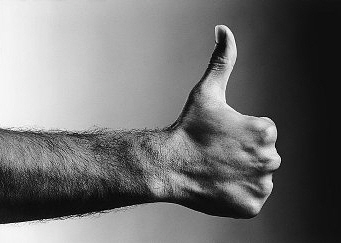
This can mean 'Good', 'One', 'Up yours' or 'Sit on this' depending where you live
Being the most powerful digit on the hand it is used as a sign of power and can be seen protruding from pockets and sport jackets. The thumb is also used, in combination with other gestures, as a power and superiority signal or in situations where some people try to get us 'under their thumb'. The thumb is referred to in this expression because of its physical power.
3. The V-Sign
This sign is common in Great Britain, Australia, and New Zealand and carries an 'up yours' interpretation. Winston Churchill popularized the 'V for victory' sign during the Second World War, but his two-fingered version was done with the palm facing out, whereas the palm faces towards the speaker for the obscene insult version.

This can mean 'two' to an American, 'Victory' to a German and 'Up yours' in Britain
Its origin can be traced back centuries to the English archers who used these two fingers to fire their arrows. It was considered the ultimate degradation for a skilled archer to be captured and, rather than be executed, have his two shooting fingers removed. The two-fingered V sign quickly became used as a goading signal in battle by the British to show their enemies 'I've still got my shooting fingers.'
In parts of Europe, however, the palm-facing-in version still means 'victory' so an Englishman who uses it to tell a German 'up yours' could leave the German thinking he'd won a prize. This signal now also means the number two in some parts of Europe, and if the insulted European was a bartender, his response could be to give an Englishman, American or Australian two mugs of beer.
To Touch or Not to Touch?
Whether or not someone will be offended by being touched during conversation depends on their culture. For example, the French and Italians love to continually touch as they talk, while the British prefer not to touch at any time unless it's on a sports field in front of a large audience. Intimate embracing by British, Australian and New Zealand sportsmen is copied from South American and Continental sportsmen who embrace and kiss each other after a goal is scored and continue this intimate behavior in the dressing rooms. The moment the Aussies, Brits and Kiwis leave the field, it reverts to the 'hands off - or else' policy.
British men will only touch each other on a sports field when someone scores a point or a goal and then it's a full embrace, kiss and the odd grope. But try it on in the pub and see what happens.
Dr Ken Cooper also studied touch frequencies in a number of countries and recorded the following results for touches per hour - Puerto Rico 180, Paris 110, Florida 2, London 0.
From research and personal experience, here is a list of places where it is acceptable to touch or, to avoid touching:
Don't Touch
Germany
Japan
England
USA & Canada
Australia
New Zealand
Estonia
Portugal
Northern Europe
Scandinavia
Do Touch
India
Turkey
France
Italy
Greece
Spain
Middle East
Parts of Asia
Russia
How to Offend Other Cultures
When it comes to inadvertently offending other cultures, Americans usually take first prize. As mentioned, most Americans don't have a passport and believe the rest of the world thinks like them and wants to be like them. Here is a picture of the George W Bush family using the signature gesture of their home state Texas Longhorn football team. The index finger and little finger represent the horns of the bull and this football gesture is recognized by most Americans.
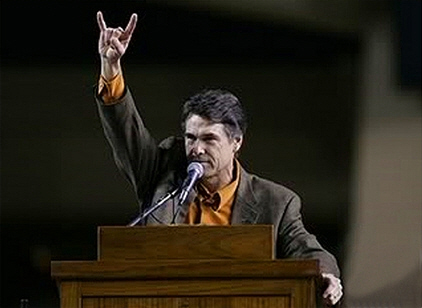

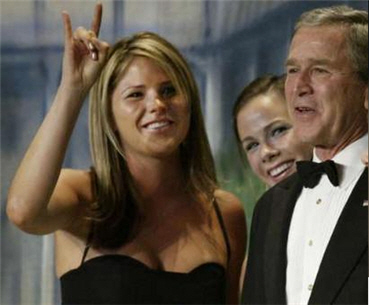
Sign of the Devil to some people. Showing this American football gesture is a jailable offense in Italy
In Italy this gesture is known as the 'Cuckold' and is used to tell a man that other men are screwing his wife. In 1985, five Americans were arrested in Rome for jubilantly dancing and using this gesture outside the Vatican following the news of a major Texas Longhorns football win in the United States. Apparently the Pope was unimpressed.
Summary
People do business with people who make them feel comfortable and it comes down to sincerity and good manners. When entering a foreign country, concentrate on reducing the broadness of your body language until you have the opportunity to observe the locals. A simple way to learn and understand cultural body language differences is to record several foreign films and replay them with the sound off, but don't read the subtitles. Try to work out what is happening then watch again and read the subtitles to check your accuracy.
If you're not sure how to be polite in someone else's culture, ask the locals to show you how things are done.
Cultural misinterpretation of gestures can produce embarrassing results and a person's background should always be considered before jumping to conclusions about the meaning of his or her body language and gestures.
If you regularly travel internationally, a good resource is Roger Axtell's Gestures: Do's and Taboos of Body Language Around the World. Axtell identified over 70,000 different physical signs and customs globally and shows you how to do business in most cultures.



